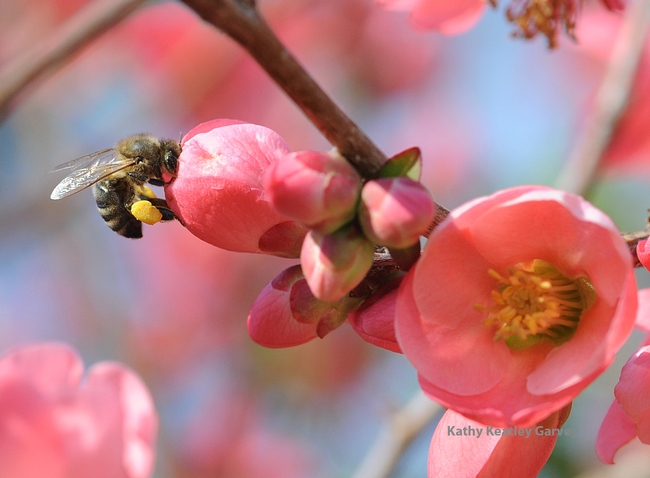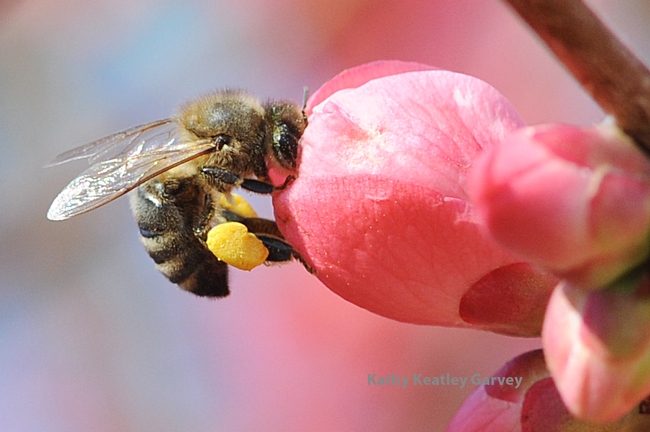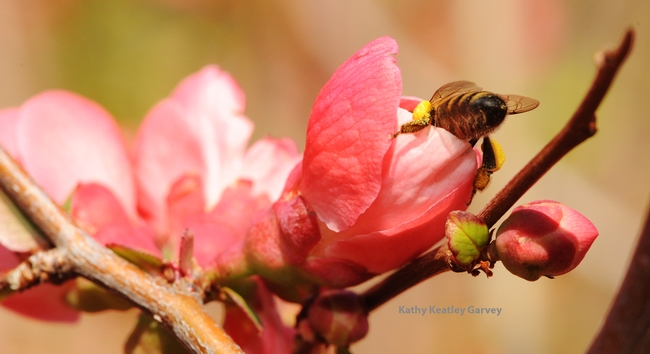- Author: Kathy Keatley Garvey
'Tis the season for the return of the insects.
Many a honey bee foraged in the flowering quince (Chaenomeles speciosa) last weekend. But wait, what's that? A spotted cucumber beetle (Diabrotica undecimpunctata) tucked inside a blossom.
Spotted cucumber beetles, which overwinter as adults, are major agricultural pests. The beetle is so named because of its preference for cucumbers (cucurbits), but just about anything will do before, during and after the cucumber crop. True, it gravitates toward other members of the cucurbits family, including squashes, gourds, pumpkins and melons, but it also goes after beans, peas, corn, potatoes, beets, tomatoes, eggplants, cabbage, and assorted ornamentals, such as roses and dahlias.
The yellowish-green beetle with black spots may look pretty tucked inside a flowering quince, but looks are deceiving.
Very deceiving.


- Author: Kathy Keatley Garvey
"Where'd that yellow pollen come from?"
Beekeepers who watch their bees return to their hives with pollen loads like to guess the origin of the pollen. Red, yellow, blue, white...
It's not unlike "What Color Is Your Parachute?" the job-hunting guide by Richard N. Bolles.
Sunday the bees foraging in flowering quince collected yellow pollen--heavy loads of pollen. They struggled with the weight and then headed home to help feed their colonies.
Blue skies, pink flowers, yellow pollen...life is good.



- Author: Kathy Keatley Garvey
When the honey bee meets the flowering quince, the bee is "the belle of the ball."
The winter ball.
Suddenly the flowering quince (genus Chaenomele) transforms the bleak wintery landscape into a spring ballroom of sorts. The giddy bee is a joy to see.
Around here, the ornamental flowering quince, a member of the rose family (Rosaceae), usually blooms around late January or early February. The tightly woven pink buds unfold amid the tangled, dreary limbs that still denote winter but promise spring.
When you watch the bees, sometimes you can't tell where the pollen load ends and the anthers begin.
Extension apiculturst Eric Mussen of the UC Davis Department of Entomology encourages gardeners to plant flowers that will bloom in late winter or early spring. The bees, he says, are hungry.
Indeed they are.
The flowering quince is a buffet for the bees and a feast for our eyes.



- Author: Kathy Keatley Garvey
A sure sign that winter is nearly over: when the flowering quince bursts into bloom, attracting a flotilla of foraging honey bees.
Actually, the bees began "inspecting" the flowering quince in the bud stage. "Hurry, open up!" the bees seemed to urge. "We have to start feeding our colonies."
Flowering quince (genus Chaenomeles, family Rosaceae) is an ornamental plant that's delightful to see. Who doesn't admire the soft pink blossoms and the comforting hum of bees buzzing around with heavy loads of yellow pollen?
The nation's bees, though, are still in trouble. Overwintering losses are still around 30 percent as in the years past, honey bee experts say. Bees are still suffering from colony collapse disorder (CCD), a mysterious malady characterized by adults bees abandoning the hive. CCD is thought to be the result of multiple factors, including pesticides,pests, diseases, malnutrition and stress.
As Christi Heintz, executive director of Project Apis m. (as in Apis mellifera), told the Almond Board of California at its meeting in December: “Colony losses are not quite as acute as in previous years, mainly as a result of improved management, but overwintering losses still hover around 30 percent, an unsustainable rate of loss.”
Heintz, who is the Almond Board Bee Task Force liaison, listed seven areas for best management practice (BMP) development: bee nutrition, pest control/varroa, disease control/nosema, hive mangement/equipment, colony management, business management, and BMPs for almond growers/bee rentals.
You can read the entire BMP article in Bee Culture.
Project Apis m. or PAm, serves an important role. Beekeepers and orchardists established PAm in December 2006, as a "New Vision" to fund honey bee research on managed colonies, according to its website. The organization's goal: "to fund and direct research to improve the health and vitality of honey bee colonies while improving crop production. Emphasis is placed on research studies that have realistic and practical usefulness for beekeeping businesses."
"PAm brings together representatives of the American Honey Producers Association (APHA), the American Beekeeping Federation (ABF), the National Honey Board (NHB), California State Beekeepers Association (CSBA), and California almond farmers. PAm includes representatives from both the pollination and crop production enterprises."
Together we can all do our part to help save the bees. The first step: awareness.



- Author: Kathy Keatley Garvey
There's nothing like a steaming hot cup of coffee to jump-start the day.
If there's anything better than one cup, it's TWO cups.
Well, honey bees like a little caffeine, too.
And nicotine.
Scientists at the University of Haifa, Israel, found that bees prefer nectar with a small concentration of caffeine and nicotine over nectar without those substances. The bees like the amount naturally found in nature and not at the higher, more toxic levels.
A news release posted on EurekaAlert noted that the bees "clearly" favored the blossoms that gave them a little buzz.
What's caffeine and nicotine doing in flowers, you ask? Did someone pour coffee or stub their cigarette in the blossoms? No. Some plant species naturally have a little caffeine or nicotine in their floral nectar.
"Nicotine is found naturally in floral nectar at a concentration of up to 2.5 milligrams per liter, primarily in various types of the tobacco tree (Nicotiana glauca)," wrote communications specialist Rachel Feldman of the University of Haita in her news release. "Caffeine is found at concentration levels of 11-17.5 milligrams per liter, mostly in citrus flowers. In the nectar of grapefruit flowers, however, caffeine is present in much higher concentrations, reaching 94.2 milligrams per liter."
What the researchers did was offer "clean" nectar (comprised of just sugars) and artificial nectar (comprised of various natural sugar levels, coupled with various levels of caffeine and nicotine).
The bees honed in on the spiked nectar.
It's important to point out, however, that the study proved a preference, not an addiction.
And yes, the next step is to study whether the bees can become addicted to the substances.
Honey, would you like a little sugar in your coffee, or a little coffee in your sugar?




